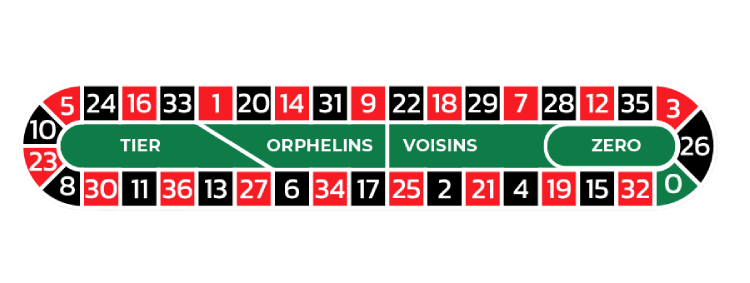
If you’ve spent any time at a roulette table, you’ll know the game offers more than just red or black. Alongside its various formats and betting styles, one option you might come across is the neighbour bet—a feature especially common in European-style games.
In this blog post, we’ll explain what neighbour bets are, how they work, and how you can place them if you’re playing roulette. Whether you're new to the concept or simply looking to understand it better, this guide will help you get to grips with this unique betting option.
Read on to learn more.
Neighbour Bet Rules
A neighbour bet allows players to wager on a specific number along with the numbers positioned next to it on the roulette wheel. These bets are typically placed using the racetrack layout found on many European and French roulette tables.
Unlike standard bets placed directly on the betting grid, neighbour bets must be called out to the dealer. Players cannot place these wagers themselves, so understanding the proper process is essential.
Here’s how neighbour bets are usually placed:
-
Call the bet to the dealer: Players should clearly state their chosen number, the number of neighbours on each side, and the total stake. For example, “17 and the neighbours for £5.”
-
Prepare the chips: The total amount of the bet should be placed on the table within easy reach of the dealer. Chips should never be handed directly to the dealer, as this is considered poor etiquette.
-
Place the bet in time: Neighbour bets can only be placed once the previous spin has finished and all bets have been settled. Because these bets require dealer interaction, it’s best not to wait until the last moment.
-
Using larger denomination chips: If a player only has a higher-value chip than the intended stake, they can still call the bet, and the dealer will return the difference as change.
Neighbour bets offer a structured way to cover a section of the wheel, but they do require clear communication and timing to be accepted properly.
What Numbers Can You Cover With a Neighbour Bet?
Neighbour bets are based on the sequence of numbers as they appear on the —not on the layout of the betting grid. Typically, this bet covers a group of five numbers: the chosen number plus the two numbers directly adjacent to it on either side.
However, depending on the casino, players may be able to adjust the number of neighbours included—anywhere from one to nine on each side of the selected number. This flexibility allows players to cover a wider or narrower section of the wheel, depending on their approach or preference.
How Much Does a Neighbour Bet Cost?
The total cost of a neighbour bet is determined by how many numbers are being covered. Since each number is treated as an individual straight-up bet, players must stake the table minimum on each. For instance, if the minimum bet per number is £1 and five numbers are selected, the total stake would be £5.
If you intend to place this type of bet, to calculate the total cost, you simply multiply your intended stake per number by the total number of numbers being covered.
Neighbour Bet Odds
Because a neighbour bet consists of individual straight-up bets, each number has the standard 1 in 37 chance of winning on a single-zero roulette wheel—roughly 2.7%. A five-number neighbour bet, therefore, provides about a 13.5% chance of success per spin.
Each winning number in a neighbour bet pays out at the usual straight-up odds of 35:1. However, as the total bet is spread across multiple numbers, the overall return must be considered in the context of the full stake placed.
How To Play Neighbours In Roulette
If you choose to place a neighbour bet, the process is slightly different from placing standard inside or outside bets. These bets are made using the racetrack layout, which reflects the actual sequence of numbers on the roulette wheel rather than the betting grid.

Here’s a simple step-by-step guide, particularly useful if you’re playing online:
-
Locate the racetrack: In a land-based casino, the racetrack is usually a separate area on the table. In online roulette, you may need to tap an icon to open the racetrack view.
-
Set your stake: Choose your chip value, which determines how much you’re betting on each number.
-
Choose the number of neighbours: Use the plus or minus buttons to adjust how many numbers are included on each side of your chosen number. The default is usually two neighbours.
-
Select your central number: Pick any number on the wheel to serve as the centre of your neighbour bet.
-
Spin the wheel: Once your bet is placed, you’re ready to start the game.
Neighbour bets offer a different approach to roulette, focusing on a section of the wheel rather than specific areas of the grid. If you're looking to explore alternative betting styles, this might be an interesting option to try.
Conclusion
Neighbour bets add a unique dimension to roulette by allowing players to cover a section of the wheel rather than relying solely on the grid. By selecting a central number and including its immediate neighbours, players can approach the game with a different approach—one that focuses on the layout of the wheel itself rather than just the numbered layout on the table.
As always, if you intend to play roulette, it’s important to keep responsible gambling practices in mind and to never wager more than you are willing to lose.
*All values (Bet Levels, Maximum Wins, etc.) mentioned in relation to this game are subject to change at any time. Game features mentioned may not be available in some jurisdictions.
**The information provided in this blog is intended for educational purposes and should not be construed as betting advice or a guarantee of success. Always gamble responsibly.
